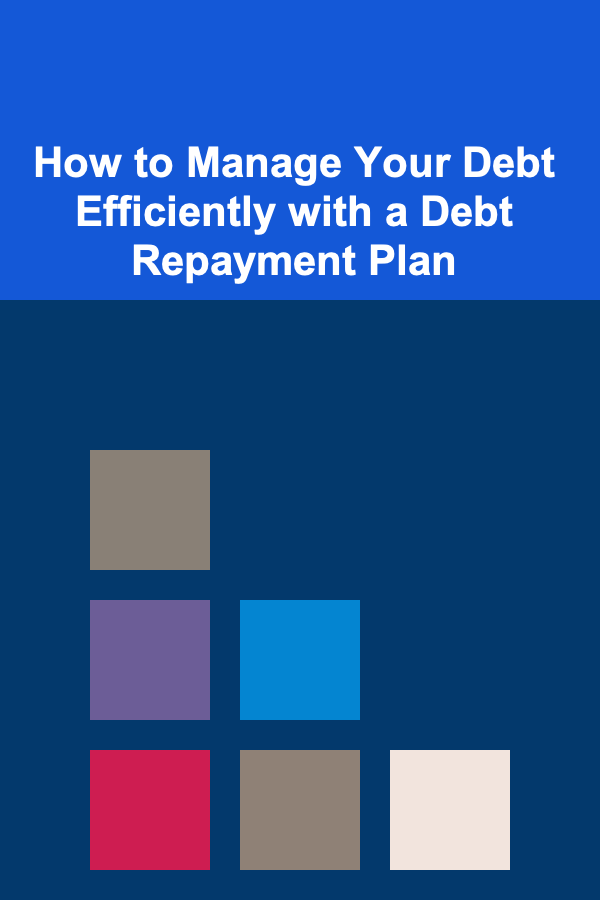
How to Manage Your Debt Efficiently with a Debt Repayment Plan
ebook include PDF & Audio bundle (Micro Guide)
$12.99$5.99
Limited Time Offer! Order within the next:

Debt can be overwhelming, stressful, and difficult to manage, especially when it seems to grow faster than your ability to pay it down. However, understanding how to tackle debt efficiently with a structured debt repayment plan can help you regain control, reduce financial stress, and eventually become debt-free.
A debt repayment plan is a strategy for managing your debt and systematically paying it off in a manageable way, ensuring you make progress over time. It's important to have a clear and organized approach to paying off debt so that you can build long-term financial health and avoid falling back into the same cycle of debt.
In this article, we'll dive deep into what a debt repayment plan is, why it's important, and provide a comprehensive guide on how to create and execute a plan that works for your unique financial situation.
Understanding Debt and the Need for a Repayment Plan
What is Debt?
Debt occurs when you borrow money or acquire goods and services with a promise to pay later. Common forms of debt include credit card debt, student loans, personal loans, mortgages, car loans, and medical debt. The amount you owe can accumulate interest, which increases your overall debt burden, making it more challenging to pay off over time.
While debt can sometimes be necessary (such as taking out a mortgage or student loan for long-term investment), it becomes problematic when you fail to manage it effectively, leading to high interest rates, late fees, and damaged credit scores.
Why Should You Have a Debt Repayment Plan?
A debt repayment plan is crucial because it helps you organize your finances and pay off your debts more efficiently. Without a repayment plan, you may find yourself making minimum payments or juggling multiple debts without a clear strategy. This can lead to more interest accruing, longer repayment periods, and financial stress.
A structured plan enables you to focus on one debt at a time, manage your cash flow, and develop positive habits that can lead to financial independence.
Steps to Create a Debt Repayment Plan
Creating an effective debt repayment plan starts with understanding the types of debt you have and how to prioritize them. Below are the key steps to follow when creating a debt repayment plan.
Step 1: Evaluate Your Debt
Before you can make a repayment plan, you need to assess your current financial situation and understand the full extent of your debt. List all the debts you owe, along with their interest rates, minimum payments, and outstanding balances. This gives you a clear overview of what you're working with.
Create a Debt Inventory:
- Debt Name: Credit cards, personal loans, student loans, etc.
- Creditor Name: The organization or bank you owe money to.
- Total Amount Owed: The current balance.
- Interest Rate: The annual percentage rate (APR).
- Minimum Monthly Payment: The minimum you are required to pay each month.
You can use a spreadsheet or an app to help organize this information.
Step 2: Set Your Financial Goals
Once you have a clear picture of your debt, it's time to set some goals. Financial goals should be specific, measurable, achievable, relevant, and time-bound (SMART). Setting clear goals will give you something to work toward and keep you motivated.
Some common debt-related goals include:
- Paying off a specific debt by a certain date.
- Reducing your total debt balance by a certain percentage within the next year.
- Becoming debt-free in a specific timeframe.
Think about how long you want to take to pay off your debt and what you're willing to sacrifice in the short term to achieve these goals.
Step 3: Determine Your Repayment Strategy
With your debt inventory and goals in mind, it's time to decide on the best repayment strategy for you. There are several popular methods, each with its advantages and drawbacks.
1. Debt Snowball Method
The debt snowball method involves paying off your smallest debts first, regardless of interest rate, and then moving to larger ones as each debt is paid off. This method is popular because it provides quick wins and builds momentum.
-
How it works:
- List all your debts from smallest to largest balance.
- Make the minimum payments on all debts except the smallest.
- Put all extra funds toward paying off the smallest debt.
- Once the smallest debt is paid off, move to the next smallest and repeat the process.
-
Pros:
- Quick wins and motivation as you eliminate smaller debts.
- Easy to follow and reduces overwhelm.
-
Cons:
- It may take longer to pay off high-interest debts if you're focusing on smaller debts first.
2. Debt Avalanche Method
The debt avalanche method prioritizes paying off high-interest debts first, which reduces the amount of interest you pay over time.
-
How it works:
- List all your debts from highest to lowest interest rate.
- Make the minimum payments on all debts except the one with the highest interest rate.
- Put all extra funds toward the debt with the highest interest rate.
- Once the highest-interest debt is paid off, move to the next highest and repeat.
-
Pros:
- You save money on interest in the long term.
- More efficient for paying off high-interest debts quickly.
-
Cons:
- It may take longer to pay off your first debt, as you might be focusing on larger debts.
3. Debt Consolidation
Debt consolidation involves combining multiple debts into a single loan or credit line, often with a lower interest rate. This can make your payments more manageable and simplify your financial situation.
-
How it works:
- You take out a loan or use a balance transfer credit card to pay off all your existing debts.
- You make one monthly payment to the new lender.
-
Pros:
- Simplifies debt management by consolidating multiple payments into one.
- Potentially lower interest rates, depending on the terms of the consolidation loan.
-
Cons:
- Some consolidation loans have fees, and you may end up extending the length of time it takes to pay off your debt.
- If you don't change your spending habits, you might accumulate more debt.
Step 4: Create a Monthly Budget
A debt repayment plan isn't complete without a budget. Your budget will help you allocate funds to pay off debt while still covering your living expenses. A monthly budget ensures that you can make consistent payments and manage your cash flow effectively.
Key Elements of a Budget:
- Income: List all sources of income, including your salary, side gigs, or other streams of revenue.
- Fixed Expenses: Include rent, utilities, insurance, car payments, and other regular bills.
- Variable Expenses: List food, entertainment, transportation, and other fluctuating costs.
- Debt Payments: Allocate a specific amount of money each month toward paying off debt.
To stick to your budget, be mindful of your spending habits and prioritize paying off debt. It may be helpful to use budgeting apps like Mint, YNAB (You Need A Budget), or EveryDollar to track your progress.
Step 5: Automate Payments and Set Reminders
Automating your debt payments is a great way to ensure that you never miss a payment and incur late fees. Set up automatic transfers for your monthly debt payments, even if it's just the minimum amount required. Many banks and lenders offer automated payment options through online banking platforms.
Additionally, set reminders for non-automatic payments, such as if you want to make extra payments toward your debts. This ensures that you stay on track and continue making progress.
Step 6: Cut Expenses and Increase Income
To speed up your debt repayment process, it's helpful to cut unnecessary expenses and find ways to increase your income. The more money you can free up, the more you can put toward debt.
Ways to Cut Expenses:
- Cook meals at home instead of dining out.
- Cancel subscriptions and memberships you no longer use.
- Downsize your living situation or find cheaper alternatives for necessities.
Ways to Increase Income:
- Take on a part-time job or freelance work.
- Sell items you no longer need or use.
- Offer your skills or services on platforms like Fiverr, Upwork, or TaskRabbit.
Step 7: Monitor Your Progress and Adjust as Needed
Lastly, regularly review your debt repayment plan to track your progress. If you're ahead of schedule, consider using that extra money to pay off your next debt faster. If you encounter financial difficulties, adjust your plan accordingly to stay on track.
Dealing with Challenges During Debt Repayment
While executing your debt repayment plan, you may face obstacles along the way. It's important to stay focused and be adaptable.
Potential Challenges:
- Unexpected Expenses: Emergencies like medical bills or car repairs can disrupt your plan. Keep an emergency fund to cover unexpected costs.
- Income Fluctuations: If you experience a drop in income, you may need to reduce the amount you pay toward debt temporarily. Just ensure you continue making minimum payments to avoid penalties.
- Burnout: Paying off debt can feel like a long and exhausting journey. Celebrate small victories to stay motivated and remind yourself of the bigger picture.
Conclusion
Managing debt efficiently with a debt repayment plan is a crucial step toward achieving financial freedom. By assessing your debt, setting clear goals, choosing the right repayment strategy, creating a budget, and staying disciplined, you can regain control of your finances and ultimately become debt-free.
Remember, consistency and patience are key. It may take time, but with a well-executed plan, you'll see your debts decrease and your financial confidence grow.
Reading More From Our Other Websites
- [Trail Running Tip 101] Hit the Trail: How Trail Running Can Kickstart a New Chapter in Your Life
- [Home Pet Care 101] How to Keep Your Pet's Skin Healthy and Free of Irritations
- [Soap Making Tip 101] The Beginner's Guide to DIY Lye-Free Soap: Tools, Ingredients, and Tips
- [Personal Financial Planning 101] How to Get Out of Credit Card Debt and Stay Debt-Free
- [Simple Life Tip 101] Best Indoor Gardening Tips for a Simple Life in Small Urban Apartments
- [Survival Kit 101] How to Build a Compact Survival Kit for Urban Cyclists Facing Traffic Accidents
- [Organization Tip 101] How to Utilize Digital To-Do Lists for Increased Productivity
- [Home Budget Decorating 101] How to Create a Stylish Gallery Wall Without Breaking the Bank
- [Personal Investment 101] How to Invest in a Vanguard Personal Pension for Long-Term Growth
- [Home Rental Property 101] How to Use Rental Agreements to Protect Your Property

How to Handle Pet Waste Disposal in Your Home
Read More
The Passive Income Potential of Deep Learning in the AI Space
Read More
How to Master Light Painting
Read More
How To Create a Flexible Work Schedule for FIRE
Read More
Leveraging Open Source Marketing Tools
Read More
10 Tips for Rehearsal Blocking with Limited Space
Read MoreOther Products

How to Handle Pet Waste Disposal in Your Home
Read More
The Passive Income Potential of Deep Learning in the AI Space
Read More
How to Master Light Painting
Read More
How To Create a Flexible Work Schedule for FIRE
Read More
Leveraging Open Source Marketing Tools
Read More